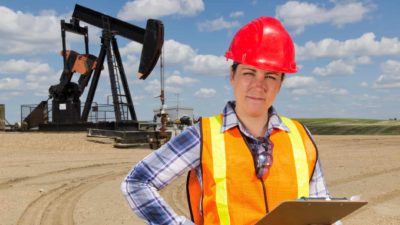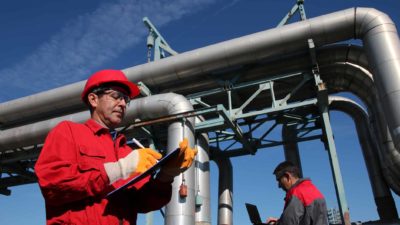S&P/ASX 200 Index (ASX: XJO) oil shares took some of the biggest hits on the ASX during the initial fallout from the COVID-19 pandemic.
Oil prices fell through the floor. Demand dried up almost overnight as global lockdowns and border closures grounded aircraft and left cars sitting in their garages for weeks at a time.
On 3 January 2020, a barrel of Brent crude was selling for US$68.60 (AU$90.26 at today's exchange rate). By 24 February, that same barrel was selling for US$21.44, a fall of 59%.
Little wonder that ASX 200 oil shares took a bath in the early months of 2020.
How these 3 ASX 200 oil shares moved in the wake of the pandemic
For the purposes of this article, I've put the microscope on the 3 biggest ASX 200 oil shares. Namely:
- Woodside Petroleum Ltd (ASX: WPL), with a market cap of $21.8 billion
- Santos Ltd (ASX: STO), with a market cap of $15.0 billion
- Oil Search Ltd (ASX: OSH), with a market cap of $7.9 billion
So, how did these powerhouse ASX 200 oil shares perform early on in 2020?
Not well!
The Woodside share price crashed 54% from 3 January through to its 20 March 2020 low. The Santos share price crumbled 64% over that same time frame. The Oil Search share price fell a gut-wrenching 69%.
Now all 3 of these ASX 200 oil shares have delivered sizeable gains to investors who bravely picked up their shares at these lows.
Woodside has gained 41% since 20 March 2020; Santos has gained 132%; and Oil Search shares are up 66%. By comparison, the ASX 200 has gained 52% over this period.
But here's the thing.
All 3 oil majors are still trading well below their pre-COVID levels, even as the oil price has surpassed its early 2020 level.
Oil price rockets back but ASX 200 oil shares lag
Today, a barrel of Brent crude is fetching US$75.76.
I'll save you scrolling back up to the top and tell you that's more than 10% higher than the US$68.60 per barrel Brent was trading for at the start of 2020.
Yet, while they've posted large gains since the lows, these 3 ASX 200 oil shares have yet to recoup much of their pandemic-driven losses.
The Woodside share price is still down 35% from 3 January 2020. Santos shares remain down 15%. The Oil Search share price is down 48% since the beginning of 2020.
With the Brent crude price up 10% in that same time, many analysts are forecasting even higher oil prices ahead.
Why crude oil could hit US$100 per barrel
Forecasting longer term energy prices is right up there with forecasting longer term foreign exchange fluctuations. In other words, there are a heck of a lot of variables at play.
But in the medium term, analysts can get a decent handle on likely potential price moves by gauging basic supply and demand dynamics.
On the demand side, the world is beginning to reopen amid vaccine rollouts. Should that reopening continue without major glitches from COVID variants, pent up demand for domestic and international travel should continue to put upward pressure on crude oil prices.
On the supply side, US shale production remains well below pre-pandemic levels. In addition, OPEC+ is, at the moment, still restricting output from its members. While the cartel might opt to increase supply when it meets next week, expectations are that any increase will be modest.
Petrol stockpiles in the United States, the world's biggest economy, are also down.
As Bloomberg reports:
[A] U.S. government report earlier showed crude supplies, gasoline inventories and stockpiles at the nation's largest storage hub at Cushing, Oklahoma, all tumbled last week, reinforcing the expectation of limited supply during the summer driving season.
Tuesday's Qatar Economic Forum also reinforced the notion that crude oil prices could go higher, all the way to US$100 a barrel. During the forum, leaders of major oil firms cited a lack of investment in oil and gas projects as putting upward pressure on prices.
There's "quite a chance" crude will reach $100 a barrel, TotalEnergies SE Chief Executive Officer Patrick Pouyanne said at the Forum.
The International Energy Agency has also forecast a crude supply crunch in the second half of 2021, if new supply doesn't come online.
India, the world's second most populous nation, is already struggling with high energy costs. The country is amongst those urging OPEC+ to open the taps wider.
From Bloomberg:
India has once again urged OPEC and its allies to revive halted oil production as the world's third-biggest consumer expressed "deep concern" over spiraling energy prices.
"High crude prices are adding significant inflationary pressure on India," Oil Minister Dharmendra Pradhan told OPEC's top official.
Foolish takeaway
There are many different factors that determine the price of individual ASX 200 oil shares.
The price of the black gold they pump from the ground is undoubtedly a major influence on oil share prices.
If TotalEnergies' Patrick Pouyanne has it right and crude heads back to US$100 per barrel — some 32% above today's price – it should provide some healthy tailwinds for ASX 200 oil shares.








